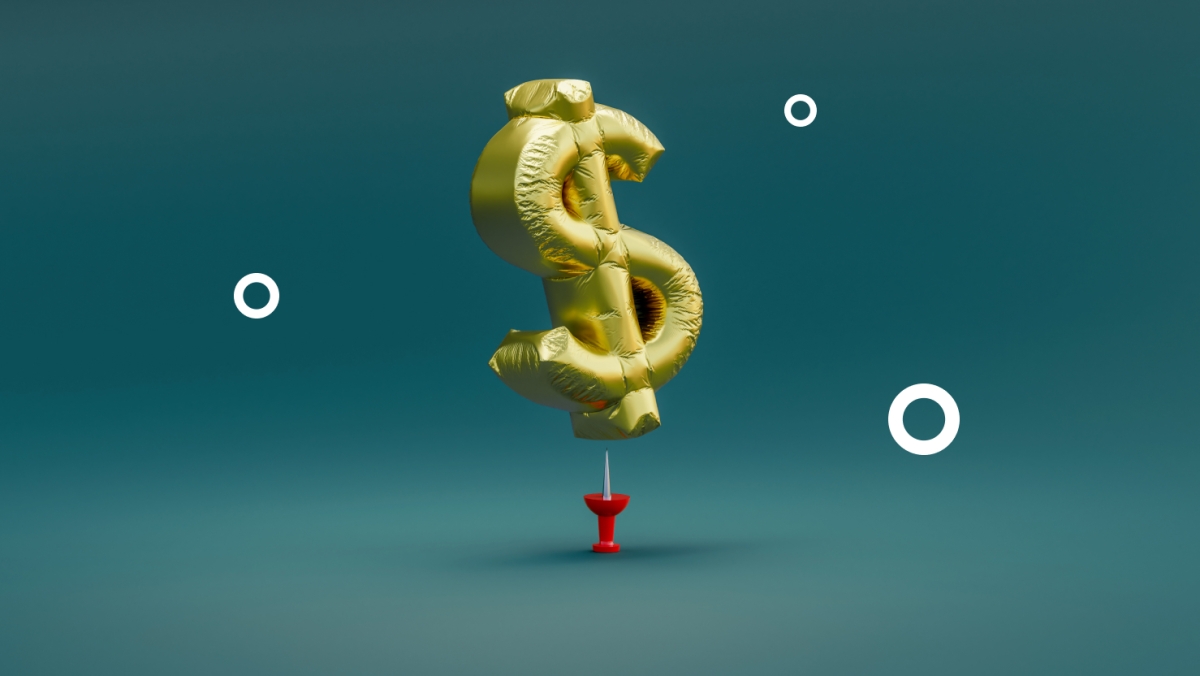What is deflation?
What is deflation?
What is deflation?

Bargain shoppers know there’s nothing better than a price drop. But a one-off sale is a world away from deflation, which is the general reduction of prices for thousands of everyday goods and services.
Not only does deflation signal a stagnating economy, it can lead to high unemployment, unaffordable debt repayment, and dismal outcomes for businesses. In the worst cases, deflation can lead an economy into a recession, or even a depression.
Deflation definition
Just like inflation, deflation is a story of supply and demand. But instead of prices for goods and services going up over time, they go down. Generally, this means purchasing power increases — people are able to buy more with the same amount of money.
Deflation often comes as a relief to consumers in the short term, but a prolonged period of deflation can be a major roadblock to economic growth.
How is deflation measured?
The Consumer Price Index, or CPI, tracks the prices of about 80,000 items on sale in the United States (plus sales or excise taxes) each month.1 There are also sub-indexes that measure prices in various regions and cities throughout the country.
There are eight major groups represented in the CPI:
- Food and beverages
- Housing (rents only)
- Apparel
- Medical care
- Transportation (including fuel costs)
- Recreation
- Education and communication
- Other goods and services
Items that aren’t included in the CPI are income taxes, Social Security taxes, stocks, bonds, real estate, and life insurance because they aren’t related to everyday consumption.
When prices rise month to month or year to year, they’re represented by a positive percentage. For example, from March 2022 to March 2023, the index for all items rose 5%. If the inflation rate a few months later is 4%, that represents disinflation — prices are dropping, but still showing overall growth. Deflation, by contrast, doesn’t occur until the inflation rate is below 0%.
What causes deflation?
As with inflation, deflation is typically caused by a change in government policy and consumers’ reactions to it. It can be difficult to isolate a single driver of rising or falling prices in the middle of the trend. Even years later, the causes are often found to be multi-faceted.
Here are three common scenarios that can lead to deflation:
- Decrease in the money supply: When the Federal Reserve deploys a tight monetary policy, that means it’s pulling back on spending and raising interest rates. This makes it harder for people to borrow money to buy goods and services.
- Decline in consumer demand: When demand falls, whether because the government is tightening its purse strings or the stock market is on a downswing and investors are hoarding more cash, businesses may lower prices to encourage people to spend.
- Increase in business productivity: Technological advances can help businesses produce more goods at a lower cost, increasing the supply on the shelves. With increased supply and level demand, prices fall (think about how cheap TVs have become).
The effects of deflation
Deflation isn’t all bad. In the short term, it can help consumers buy more with the same paycheck. Beyond that, the negative effects can mount quickly. Here are a few.
- Falling incomes/higher unemployment: When businesses are selling goods for lower prices, they earn less profit. To make up for it, they may cut wages or lay off employees, and spend less on innovation and investing in the company.
- Less consumer spending: If consumers have less income to spend, they buy fewer discretionary goods and services. Less overall spending weakens the economy, furthering a deflationary spiral. Another theory for reduced consumer spending is that perception drives outcomes — when prices are continuously dropping, people may save money and put off big purchases to hold out for a lower price tag in the future.
- More expensive debt: If the monthly payment on your mortgage or car loan stays the same, but your income falls, you’re spending more of your paycheck on debt. At the same time, the asset you’re paying off — like a house or a car — is dropping in value.
FAQs
What is deflation in simple words?
Deflation is when prices for goods and services decrease over a period of time instead of increasing, as with inflation.
What is deflation and why is it bad?
Deflation is when the inflation rate is below 0%. It’s bad, in part, because it can lead consumers to spend less now, in part because they expect prices to continue to fall; it can push businesses to lower wages or lay off employees to maintain profit levels; and it makes existing debt more expensive for many borrowers.
What happens if there is deflation?
You may see interest rates go down if there is deflation. This is a move by the Federal Reserve to stimulate growth in the economy by encouraging people to borrow and spend money. When there is more demand and a stable supply, businesses can begin to raise prices.
Is deflation worse than inflation?
Deflation is often tougher to combat than inflation, because the Federal Reserve’s biggest lever — interest rates — is limited. In a deflationary environment, the Fed wants to get people to spend more money, so it makes access to credit cheaper. It can’t get any cheaper than a 0% interest rate.
Can deflation be a good thing?
Deflation can be helpful if it’s brought on by positive factors, such as technological advances that help businesses increase production. But that kind of modernization generally leads to deflation in one industry or category of goods at a time. When prices fall across the board simultaneously, it may be difficult to control.
1 U.S. Bureau of Labor Statistics, “Consumer Price Index.”
RO2900005-0623
The content contained in this blog post is intended for general informational purposes only and is not meant to constitute legal, tax, accounting or investment advice. You should consult a qualified legal or tax professional regarding your specific situation. No part of this blog, nor the links contained therein is a solicitation or offer to sell securities. Compensation for freelance contributions not to exceed $1,250. Third-party data is obtained from sources believed to be reliable; however, Empower cannot guarantee the accuracy, timeliness, completeness or fitness of this data for any particular purpose. Third-party links are provided solely as a convenience and do not imply an affiliation, endorsement or approval by Empower of the contents on such third-party websites.
Certain sections of this blog may contain forward-looking statements that are based on our reasonable expectations, estimates, projections and assumptions. Past performance is not a guarantee of future return, nor is it indicative of future performance. Investing involves risk. The value of your investment will fluctuate and you may lose money.
Certified Financial Planner Board of Standards Inc. (CFP Board) owns the certification marks CFP®, CERTIFIED FINANCIAL PLANNER™, CFP® (with plaque design), and CFP® (with flame design) in the U.S., which it authorizes use of by individuals who successfully complete CFP Board's initial and ongoing certification requirements.
Advisory services are provided for a fee by Empower Advisory Group, LLC (“EAG”). EAG is a registered investment adviser with the Securities and Exchange Commission (“SEC”) and subsidiary of Empower Annuity Insurance Company of America. Registration does not imply a certain level of skill or training.





